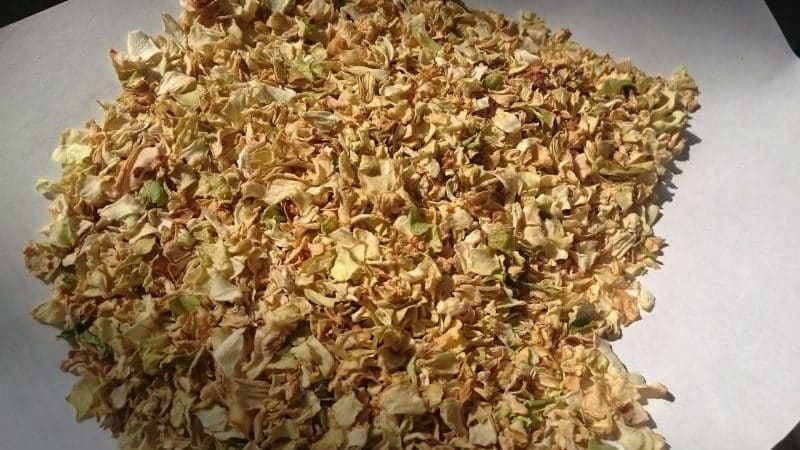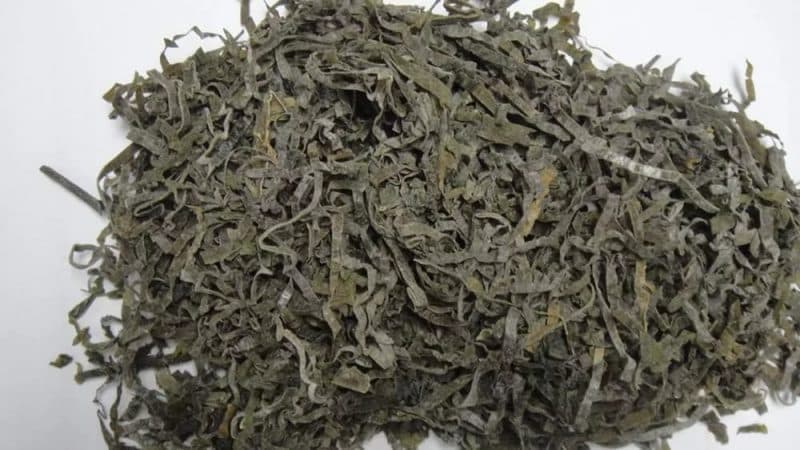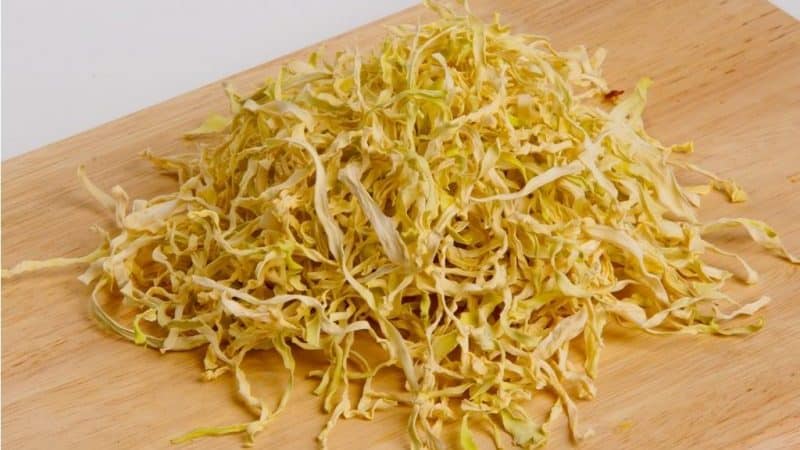How to prepare dried cabbage and where to use such preparation
Dried cabbage is not the most common way blanks canning for the winter, but it is simple and suitable for a wide variety of varieties.
In this article we will tell you how to dry cabbage at home and where to use it later.
Is it possible to dry cabbage?
Drying has different effects on different types of cabbage. Below we will analyze them in detail.
White cabbage
There are no obstacles to drying white and red cabbage. For a person, 100 g of freeze-dried (that is, dried) white cabbage is equivalent to eating 1 kg of fresh cabbage.
Red cabbage is superior to white varieties in the amount of vitamin C and carotene, and therefore brings much more benefits. The dried vegetable can be eaten alone or used as an ingredient in cooking.

Colored
When dried, cauliflower loses most of its nutrients. The best way for her storage Not drying, but freezing.
However, if desired, you can dry colored ones. Its taste will deteriorate, but not so much that it becomes a significant problem.
Broccoli
If you maintain the temperature correctly, avoiding overheating above +50°C, then dried broccoli will turn out to be a surprisingly tasty and healthy product.
Important! A properly dried vegetable has no expiration date. After sublimation of moisture, dried products can be eaten not only a year later, but also 5-10 years after drying.
Marine
From a biological point of view, seaweed, also known as kelp, is not a relative of any type of cabbage. However, drying is fine for it.
Dried seaweed with kimchi sauce or any other spices is one of the traditional dishes of Japanese and Korean cuisine. Dried spicy kelp under the brand 緑 – “Midori” (translated from Japanese as “light green, the color of the first spring greens”) is one of the popular products in Russian stores, an excellent appetizer before main courses.

Advantages and disadvantages of this harvesting method
Advantages of drying:
- Almost unlimited shelf life of preparations. If the vegetable is not moldy and all moisture has been removed from it, it can be stored for years.
- No problems with diseases. All affected heads of cabbage are selected and disposed of at the preparation stage. In the future, there is no need to monitor the workpieces - just observe the temperature and humidity conditions.
However, there are also problems:
- dried product requires special technical devices for preparation;
- drying needs to be soaked before use;
- there are losses in the mineral and vitamin composition of the vegetable.
Preservation of beneficial properties
When dried, cabbage completely retains its calorie content. However, there are losses in the chemical composition: some proteins and vitamins disintegrate due to excessive heating. Therefore, dried vegetables are not suitable as a means of combating vitamin deficiency: no matter what variety is used, the losses are too great.
In addition, the loss of taste and consistency is significant. Even after soaking, dried cabbage raw material is not suitable for salads and can only be used as a dressing for cabbage soup or borscht.
Advice. Dried cabbage is an ideal preparation for kale chips.If you plan to prepare this dish, then the raw materials are not soaked, but pieces of leaves are immediately fried in boiling oil.
Drying methods
Now let's look at ways to dry cabbage.
Any type of crop contains a lot of moisture. Therefore, after drying, the yield of finished raw materials will be no more than 1 to 10 of the total mass of cabbage. With proper drying, the loss of biologically active substances will be minimal.

In the oven
The easiest way to dry cabbage for long-term storage is to use the oven.
The technology is as follows:
- The cabbage head is washed and disassembled into leaves, with the discarding of affected, rotten and damaged leaves.
- The baking sheet on which the raw materials will be dried is greased with vegetable (olive, sunflower, or, in extreme cases, linseed) or animal (butter) oil. Instead of butter, you can use baking paper or silicone molds.
- Place the finely chopped vegetable in an even layer on a baking sheet.
- Drying is carried out for 1.5-2 hours. Temperature is about 80°C.
- The leaves are checked for readiness. Completely dried ones are sent for storage, slightly wilted ones are completely dried.
Signs of readiness:
- inflorescences decreased almost three times;
- When squeezed with fingers, no juice is released.
Ready broccoli florets take on a yellowish tint.
Attention! If, when pressed, the raw material breaks and crumbles into powder, overdrying has occurred. There is no point in storing such a vegetable: it does not contain any useful elements, and over time the powder will pick up foreign odors.
In the microwave
Drying in the microwave is almost no different from drying in the oven. The difference is that you need to dry it in 3-4 steps, regularly mixing the raw materials and turning the cup in which the chopped vegetable is placed for drying.This is due to the fact that the magnetron of a microwave oven cannot evenly heat the entire workpiece: even the best microwave ovens have “dead zones” where radiation has virtually no effect.
Therefore, they dry cabbage in the microwave, either by stirring regularly or using models with a special drying mode, where the tray rotates and ensures uniform irradiation.
In an electric dryer
Using electric dryers is not much different from oven drying.
Modern models of electric dryers are configured to maximize the preservation of the quality of raw materials. However, this does not eliminate the need to manually adjust the electric dryer: set the temperature to 55°C and dry the raw materials for 2 to 6 hours.
In a convection oven
In an air fryer, cabbage is prepared as follows:
- The raw materials are sorted and finely chopped. The greater the degree of grinding, the better.
- The finished mass is poured with boiling water to destroy putrefactive bacteria.
- The mixture is placed on the grill of the air fryer and the device is turned on. A small portion is dried for 15-20 minutes, a large portion for 1.5-2 hours.
How to check readiness
Dried cabbage has the following properties:
- turns pale due to the breakdown of the enzyme - this is especially noticeable in red-headed varieties;
- it becomes moderately dry to the touch, but elastic - if the cabbage crumbles into dust, it is overdried and has lost its beneficial properties.
How to store
Dried cabbage is stored taking into account the following conditions:
- insulation from foreign odors.
- insulation from moisture.
- isolation from other products.
The best option is to pour the dried vegetable into a glass jar with a tight lid and store it that way. Cotton bags made of thick fabric and plastic food containers are also suitable for use. Dried cabbage does not need to be sterilized or sealed.If drying is done correctly, it is enough to isolate it from moisture and odors.
Interesting! Some chefs specifically try to flavor dried raw materials using bay leaves, pepper and other additions with pungent odors.
Where and how to apply
Dry cabbage can be used in the same ways as fresh cabbage, except for preparing salads. In most cases, allowing the dried product to absorb enough water is sufficient and it can be used in the same way as raw chopped cabbage.
But keep the following in mind:
- Dried seaweed is not soaked. It is eaten dry, like chips. This is a snack, not an ingredient for preparing another dish. The exception is situations when kelp is dried without adding spices: then it is a culinary raw material.
- When cooking cabbage soup or borscht, add an extra 150-200 ml of liquid (water or broth) to a portion of dried cabbage. Otherwise, there is a risk that instead of soup you will end up with a thick porridge.
- For other dishes, soak dried cabbage in clean drinking water for 1-2 hours.
The soaking time depends on the dryness of the raw materials. The more thoroughly the cabbage is dried, the better it is stored, but also the longer it needs to be soaked before being used for food.
Reviews
This is what experienced gardeners and housewives write about dried cabbage.
Anna, Berezov: «I tried drying cabbage. A lot of work, but the effect is negligible. It’s easier, as usual, to store the heads of cabbage - then, at least, you get the usual cabbage, and not dried cabbage, with which you don’t know what to do.”
Igor, Tula: “I was drying cabbage. It is more convenient to store than fresh heads of cabbage - especially since cauliflower and broccoli are not stored fresh at all. Convenient, but then you need to use other recipes - in particular, add more water.But still, until spring we ate delicious cabbage dishes.”
Gulnara, Kislovodsk: “We tried to dry cabbage for the winter. Perhaps it would be better if we froze it. It is more convenient to store, but the labor intensity is many times greater - although there is no waste at all, because everything was carefully sorted before harvesting. There’s no difference in the soup, and we haven’t tried stewing or frying.”
This is interesting:
How to make the best cabbage preparations at home.
How delicious and easy it is to pickle cabbage for the winter using quartered heads of cabbage.
How to cook sauerkraut with horseradish and carrots is tasty and simple.
Conclusion
Dried cabbage is not the most common type of preservation, but it helps preserve until spring even those types of vegetables that generally spoil quickly. If you apply the technology correctly, then dried cabbage is a convenient culinary raw material.